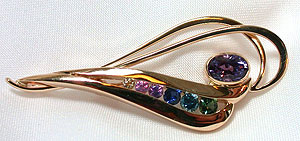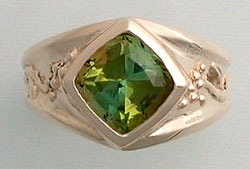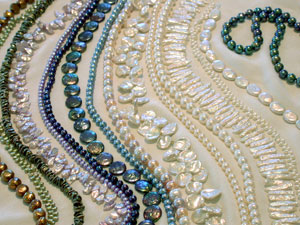  |
||||||||||||||||||||||||||||||||
| Education
Click on any of the links below to take you to additional information about the subject listed. Please don't hesitate to call or drop us a note if you have any more questions.
Cut: Even a stone with exceptional color can look boring and lifeless if itÕs cut poorly. ThereÕs much more variation in proportion when cutting colored gems than there is with diamonds. This is usually due to trying to get the best color out of the rough crystal. Sometimes itÕs taken too far: due to sloppy faceting techniques or in trying to cut the biggest stone from the crystal. In these cases, youÕll see large lifeless dark areas and/or large washed out areas. The brighter the flashes of color, the better the cut.
Clarity is not as important here as it is with diamonds; color is the priority. Carat Weight: As with diamonds, the value of a rarer gem rises quickly as the carat weight increases. Oddly enough, sometimes the per carat price of a less valuable stone (for example, amethyst) can decrease as the size increases (as when a stone is too large and cumbersome to use in jewelry). Different varieties have different specific gravities (meaning some are denser/heavier than others). A one carat ruby will be smaller than a one carat tourmaline or diamond, because the ruby has the higher specific gravity. Stated a little differently, a 6mm round ruby will weigh more than the exact same size diamond. Hardness: IÕve included hardness here because I believe that while jewelry needs to be beautiful, it must also be practical so it can be worn without worry. Hardness is the ability to withstand scratching. As we all know, diamonds are a 10 on the Mohs hardness scale. Talc represents a 1, and most gemstones fall in the 6 to 9 range. Ruby and sapphire are 9, but note that the scale is only relative: diamond is approximately 50 times harder than ruby and sapphire. The most common mineral, quartz comes in at 7. When you get to a pearl which has a hardness of just 3, you know to take special care of it.
More Information: There is an excellent website designed by the International Colored Gemstone Association which gives a wealth of information on gemstones by variety or color, famous gems, symbolism, photos etc. You can find it at www.gemstone.org. |
||||||||||||||||||||||||||||||||
© 2008 - Refined Designs Original Fine Jewelry | All rights reserved | 518-765-3750 |
||||||||||||||||||||||||||||||||
 WHAT
TO LOOK FOR
WHAT
TO LOOK FOR Clarity:
Colored gems fit into 3 classifications:
Clarity:
Colored gems fit into 3 classifications: But
thereÕs another component: toughness. This is a stoneÕs ability to
withstand chipping and cracking from a sharp blow. Tanzanite has a
hardness of 8, but itÕs not a good ring stone because itÕs not tough.
Same goes for emerald and opal. All need a protective setting if worn
as a ring, and need to be treated with extra care.
But
thereÕs another component: toughness. This is a stoneÕs ability to
withstand chipping and cracking from a sharp blow. Tanzanite has a
hardness of 8, but itÕs not a good ring stone because itÕs not tough.
Same goes for emerald and opal. All need a protective setting if worn
as a ring, and need to be treated with extra care.